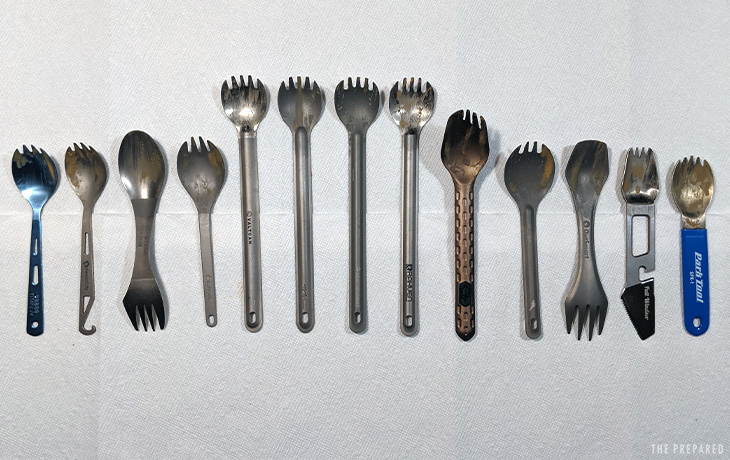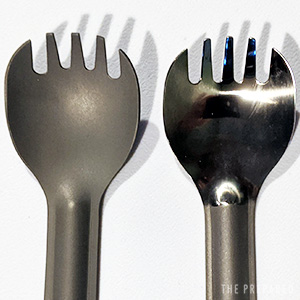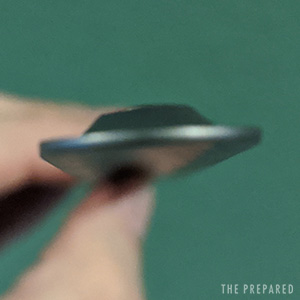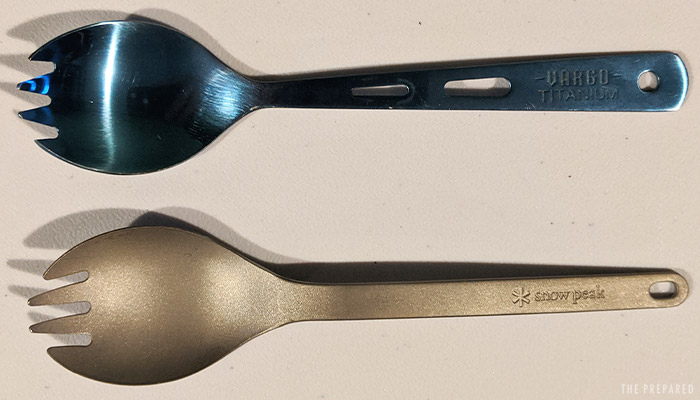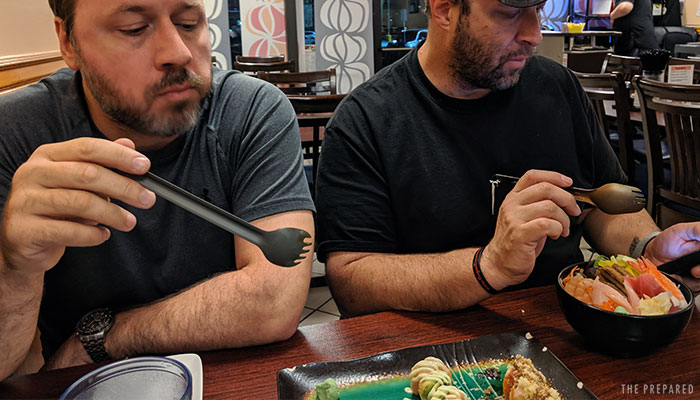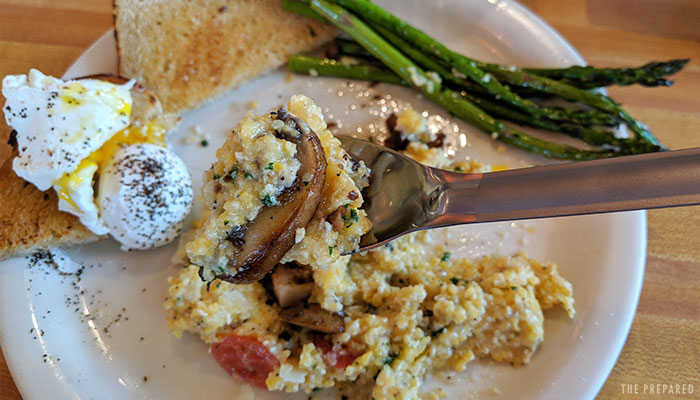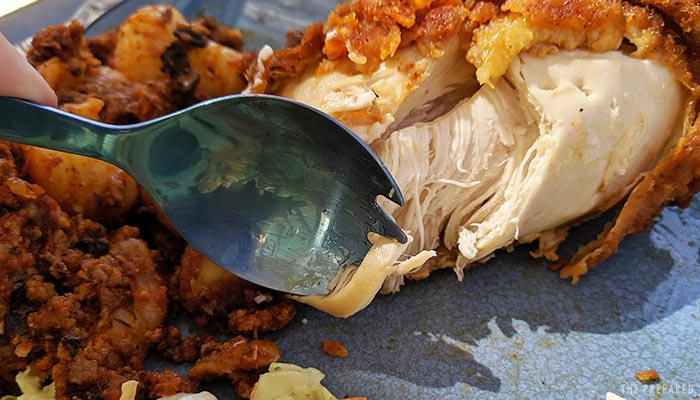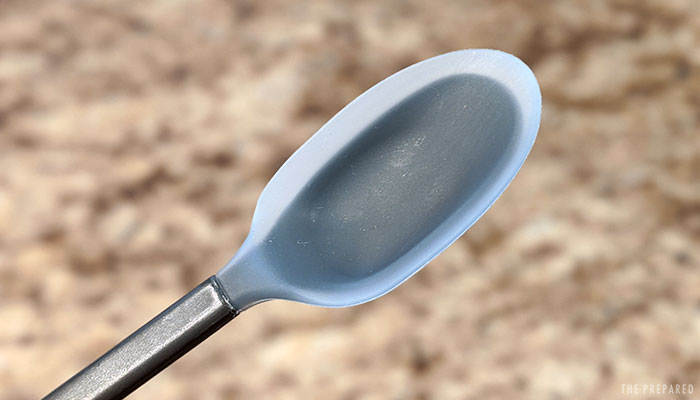Like most people, when I first started prepping, I bought the common Light My Fire Titanium Spork, a double-ended lightweight gadget that just looked right (and was well reviewed) as I was browsing Amazon. I used it in the field for years and kept it stored in my go-bag.
After testing at least 20 other models for this review — including many awkward conversations with restaurant staff who wondered why our test group brought in bags full of utensils — it turns out there are much better options for emergency preparedness.
Summary:
- A single utensil is worth carrying in your portable gear, but not more. You already have at least one cutter with a knife or multitool, for example, and can usually DIY whatever else you need.
- Don’t waste money on the useless keychain-style models.
- Double-ended sporks (fork on one end, spoon on the other) look neat, but in practice they’re just not worth it.
- Any cutting features we found, like a “knife” serrated edge on one side, were totally useless.
- You want a single piece of metal, probably either titanium or aluminum. Foldable or plastic sporks are not good enough for prepping because they too easily break under load.
- Titanium is great for the ultralight crowd, but the fractions of an ounce don’t matter much, so either titanium or aluminum are fine.
- Most sporks have either an anodized, polished, or sandblasted/matte finish. The differences aren’t huge, but we did prefer anodized/polished over sandblasted/matte.
Your main decision will be whether to go short or long, and it boils down to personal preference.
Shorter sporks give the benefit of slightly less weight and space in your bag. But you’re more likely to struggle with larger food containers and thus get food on your hand/knuckles while contaminating your food (especially with MREs and pouches), which could be more than a simple annoyance in dirty emergency scenarios or when you have limited cleaning ability.
Longer sporks are more comfortable to use, keep things cleaner, reach more places, are less likely to burn your hand over a fire, and can act as a stirring utensil for larger pots — obviously at the expense of a little more weight and space.
Although everyone in our test group had previously kept short sporks in their personal go-bags, three of the four testers have since put a long spork in their primary bag. The small cost of added space and weight was worth it for the extra versatility and comfort — and considering how people typically organize these in a go-bag (eg. the admin pocket), the extra length won’t matter in practice.
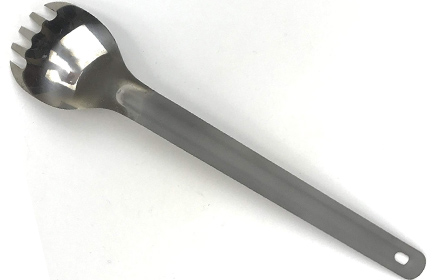
Best for most:
Rakuen Titanium Long Handle Spork
The best spork for most people is the Rakuen Titanium Long Handle Spork. It meets all of our core criteria and is priced fairly against competitors, often found around $14. Taste testers found it to be one of the most comfortable and practical to use. The polished head is easier to clean and feels more comfortable in the mouth than fully-matte versions. Construction quality feels solid and we’re not worried about it being crushed in our bags. We also liked the included neon yellow pouch, which can help with signaling in a pinch (cut the bag open to double the surface area).
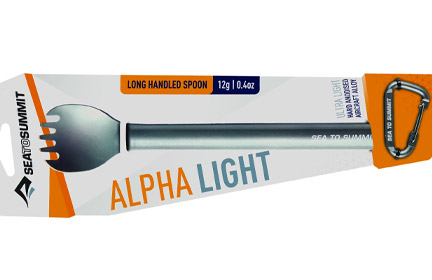
Textured:
Sea To Summit Alpha Light Long Spork
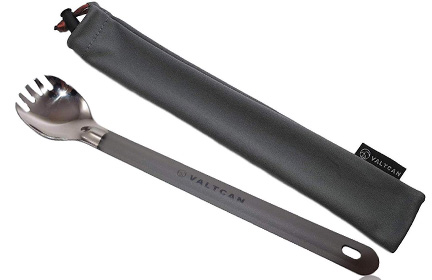
Polished:
Valtcan Titanium Long Handle Spork
The Valtcan Titanium Long Handle Spork was almost tied for first. At time of publishing, the Valtcan was the same price as the Rakuen. It’s so similar to the Rakuen that we suspect they come from the same white-label Chinese factory, just with slight differences, such as the pouch and cutoff line between polish and matte finishes (in the neck area):
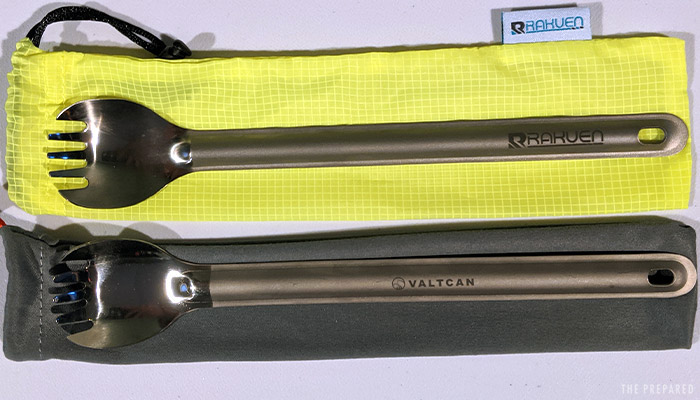
If you dislike polished heads or would prefer a uniform matte coating, the Sea To Summit Alpha Light Long Spork is another solid and popular choice. It’s the exact same dimensions as the Rakuen and Valtcan but weighs 0.2 ounces less (the reason why is explained in the coatings section down the page). The STS didn’t come with a pouch, however.
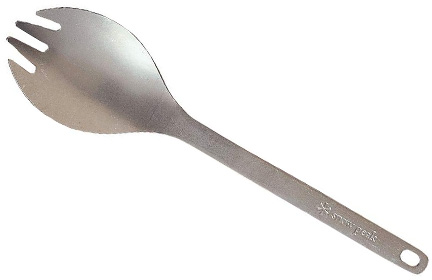
Snow Peak Titanium Spork
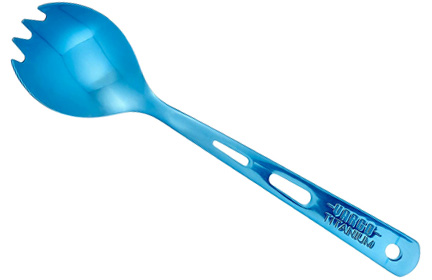
Vargo Titanium Spork
If you prefer a shorter spork for EDC or easier packing in a go-bag, we liked the Snow Peak Titanium Spork, another well-reviewed and popular choice among backcountry campers. You’ll save a few dollars and 2 inches compared to the longer models — although the weights end up essentially the same. The Snow Peak’s head was slightly larger than we’d like, but it was just on the right side of borderline for an adult mouth. It did not come with a pouch.
Also great in the short category is the Vargo Titanium Spork, with the same dimensions, weight, and cost as the Snow Peak. Both models come in a variety of colors, we just happened to mix and match in the photo above. The Vargo slightly lost out to the Snow Peak due to the shallower fork teeth, but it still performed well in our eating tests. It did not come with a pouch.
Be prepared. Don’t be a victim.
Want more great content and giveaways? Sign up for The Prepared’s free newsletter and get the best prepping content straight to your inbox. 1-2 emails a month, 0% spam.
Why you can trust this review and how we picked
Since there aren’t too many options on the market to begin with, and there weren’t already clear community favorites, we simply bought whatever seemingly-legit options we could find.
We bought some models we knew wouldn’t be winners — such as foldable sporks and those with only spoon heads and no fork teeth — to validate our past beliefs that they were disqualified designs. (Yep, validated!)
We bought all but two of these sporks. Although free samples never influence our choices, those two didn’t make the cut anyway.
Four people, all of whom are experienced with prepping and the outdoors, collectively ate over 100 meals using these sporks over a months-long period.
Types of sporks (and what to avoid)
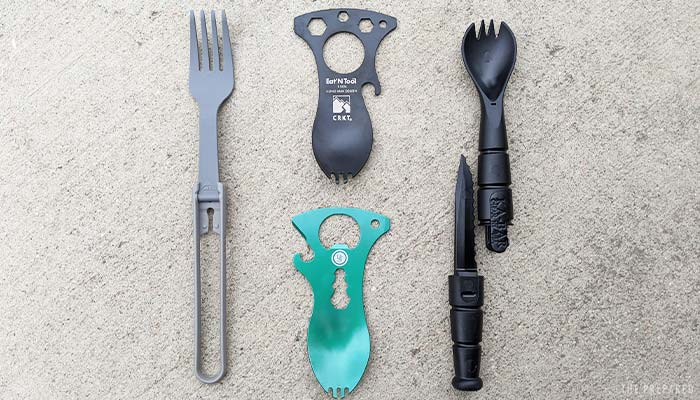
Almost every notable spork comes in either titanium or aluminum. The ultralight hiking crowd may care, but in practice, you don’t need to worry about the differences.
The market usually split into these buckets:
- 3-4” keychain models
- 6.5” single-piece models
- 8.5-9” single-piece models
- Foldable models
- Gimmicky models
Right away, the keychain, foldable, and gimmicky models are a no-go. The keychain models, for example, would only possibly be useful if you were starving but for some reason couldn’t clean your hands or find any other clean implement around you. Outside of that scenario, these models were worthless.
Skip the double-ended designs
We personally used double-ended sporks while camping for years. It wasn’t until we eventually tried single-ended designs that we realized just how frustrating the double-ended ones are.
As a general principle with technical gear, product functions are better in a silo than in a hybrid. But on double-ended models, the separate spoon and fork don’t really add much compared to the combo spork.
But the biggest problem is how you hold and use them. Double-ended models are already short to begin with (they’re often 6.5”), so you have to hold one end while eating. That means you’re touching either the spoon or fork — possibly both if you have to flip it around. That’s just silly, assuming you’re not in a clean environment with limitless soap and water.
Some double-ended models put an extreme curve in the body to try and offset this. But that just makes it super awkward to store in your bag.
Eating tests
The eating tests are where we really sorted out the winners and losers. But there’s no scientific way to judge how well a utensil eats. So for hands-on testing, four people each spent a day with a spork, rotating through until we had all used every option for multiple meals.
We ate a wide range of normal meals and the types of food you might eat in an emergency (eg. freeze-dried pouches and canned soup).
We took notes on qualities like:
- “mouth feel,” ie. how pleasant it was to put in your mouth and remove
- “forkiness,” ie. how good it was at fork things, like stabbing meat and veggies
- “spooniness,” ie. how well it scooped and held food from the container
There were clear differences in how well a spork could “spoon” food out of a pouch or pot, for example, which had to do with how angled the spoon was against the axis of your hand.
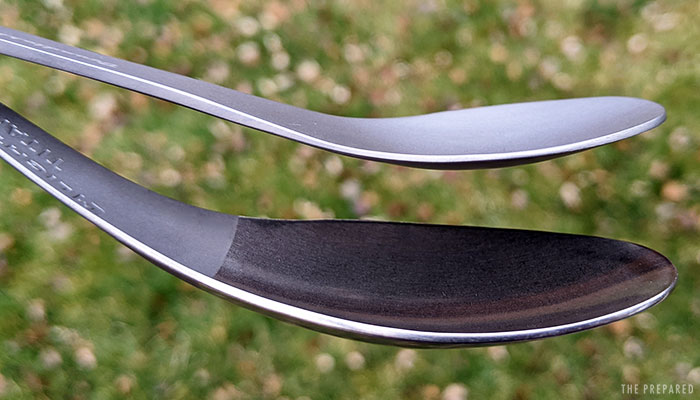
Another major difference between products was the design of the fork teeth. Some were prominent and some were wimpy — and that impacted how well you could grab, stab, and tear through meat and plants.
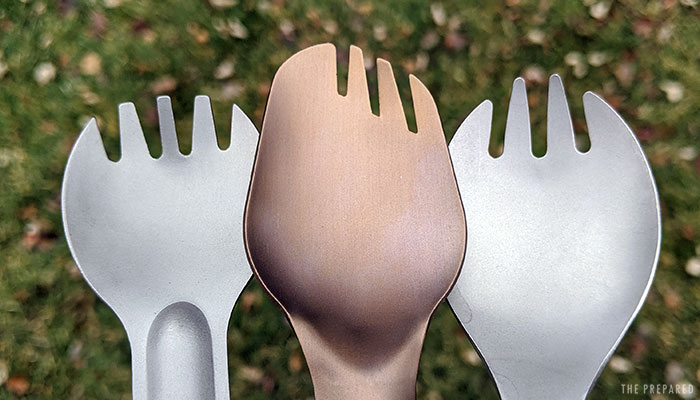
Sometimes the design of the spork itself would get in the way — even when the manufacturer thought it was a bonus feature.
For example, the GSI Essential Spoon had a unique flexible gel coating around the spoon (there’s no fork element) designed to better scrape food off the interior walls of the metallic pouches often used with Mountain-House-style meals.
That feature did in fact do really well with scraping food — which you can imagine being important in a calorie-restrained emergency — but the added bulk made putting it in your mouth unpleasant for most people.
Cleaning test
After the first rounds of testing, we didn’t yet have a good feel for what the differences were between coatings — to the point we wondered if it was all just marketing fluff.
So we thought a good practical test would be to use the sporks with the kind of food you might eat in an emergency, then let them sit overnight and try to clean them off with limited amounts of water and the kind of wet wipes or toilet paper you might have in your bag.
The primary test was with peanut butter (a common emergency food):
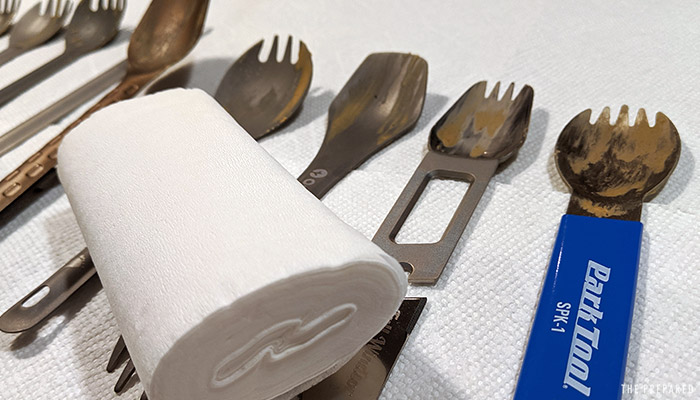
We used two squares of the same toilet paper per spork, rubbing by hand until it was clean or the paper failed.
The dried peanut butter was a challenge, and almost every spork ended up looking like this after the toilet paper scrub:
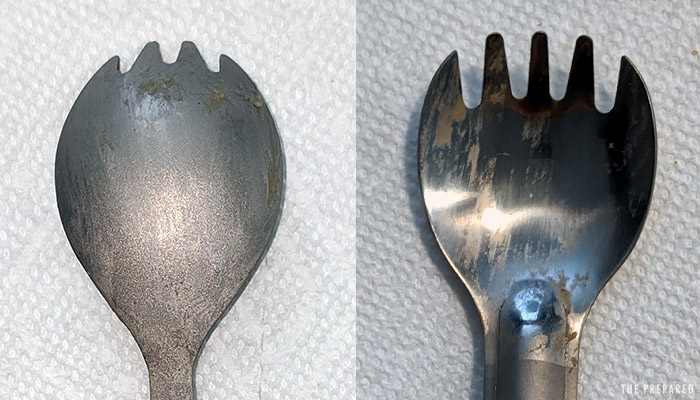
But after a few drops of water (or even a sneaky tongue lick), almost all of them got to an acceptable level of clean.
At first, we didn’t see much of a difference in cleanability between the finish styles, although some testers gave a small advantage to polished models.
Does spork coating / finish matter?
Since it wasn’t self-evident to us during testing, we spoke with manufacturers about differences in coatings. James, a manager at TOAKS Outdoor, summed things up well:
- Polished surfaces feel better in your mouth
- Sandblasted surfaces offer better grip
- Sandblasted models are (usually) slightly lighter than polished surfaces
- There’s generally no difference in cleanability or durability between polished or sandblasted
Sporks with polished surfaces are generally heavier because to create that shine, they have to sand down the rougher starting surface. But since the sanding removes material as it buffs, in order to keep the final product the right dimensions, they have to make the original cast with more of the core titanium/aluminum so there’s extra to sand down.
The end result are two products that measure the same dimensions, but the extra core material on the polished products adds a few more fractions of an ounce, compared to the sandblasted coating that adds volume but not much weight.
Ultralight backpackers might care about a small 0.3 ounce savings, but you don’t need to.
Although we didn’t hear this from a manufacturer, we do wonder if there’s a slight benefit to the polished surfaces for ease of cleaning — by definition, rougher surfaces have more nooks and crannies where food and bacteria can hide.
Which aligns with what we saw in testing, where the polished surfaces seemed to clean more easily. Or maybe it just felt that way on the mirrored surfaces because we could more easily see where things needed to be cleaned and how well cleaning was working.
Competition notes
The models we focused on during field testing:
- Be Legend Extra Long Spoon
- Boundless Voyage Titanium Spork
- CRKT Eat’N Tool
- finessCity Titanium Long Spoon Polished
- finessCity Titanium Spork
- Full Windsor The Muncher
- Gerber Devour
- GSI Outdoors Essential Spoon
- Ka-Bar Tactical Spork
- Light My Fire Titanium Spork
- MSR Folding Spork
- OutSmart 3-in-1 Ultralight Titanium Spork
- Park Tool SPK-1
- Rakuen Titanium Long Handle Spork
- Sea To Summit Alpha Light Spork
- Snow Peak Titanium Spork
- TiTo Titanium Long Handle Spork
- TiTo Titanium Spork
- TOAKS Ultralight Titanium Spork
- UST Spork
- Valtcan Titanium Long Handle Spork
- Vargo Titanium Spork
Be Legend: Just a spoon.
Boundless Voyage: Double-ended designs aren’t worth it.
CRKT: Worthless design.
finessCity long: Just a spoon.
finessCity short: Overall fine, but the teeth were a little smaller than we liked, and the bottle opener on the handle end isn’t worthwhile. Came with nice pouch.
Full Windsor: Not worth the $50 price tag. It’s technically not disqualified for being a double-ended design, since the spoon and fork portions are on the same end (as a classic spork) with a serrated cutting edge on the other. As far as spork serrations go, this was okay, but it’s still not something we care about given your other gear. Part of what you’re paying for is the “multi-function” design, which can be used as a screwdriver, bottle opener, etc. And they include a ferro rod fire starter. But again, you’ll have proper gear for those needs, so the extra cost just isn’t worth it.
Gerber: Quite disappointing. The spoon is fine, but the fork is horrible. We wonder if Gerber was being literal with their “multi-fork” marketing language: it comes with a 6-in-1 attached tool (bottle opener, pry bar, etc.) but doesn’t do any of the core jobs well. The attached tool did offer a neat advantage, though, as you could use it to prop up your spork or hang it from the edge of a pot so the food area doesn’t get contaminated.
GSI: Besides being just a spoon, the gel coating that was supposed to be the product’s defining feature was the reason we disliked it (even though the feature worked as intended, see below).
Ka-Bar: Avoid. The $5 quality is crap, it doesn’t work well as a spoon or fork, and the hidden knife is silly.
Light My Fire: Double-ended designs aren’t worth it — but this one is the king of that category.
MSR: Folding models aren’t strong enough.
OutSmart: Double-ended designs aren’t worth it.
Park Tool SPK-1: This little guy was unusual compared to the rest of the field, but we ended up liking it, and one reviewer even considered it in his top three. It’s marketed more as a tool for bicyclists than a typical bushcraft spork. It’s heavy, given the stainless steel construction, and we liked the vinyl-dipped handle. But in the end, the extra weight doesn’t add anything over the better options.
Tito long: A fine option for a long spork. There aren’t specific criticisms, but reviewers simply didn’t rank it as highly as the other options.
Tito short: Double-ended designs aren’t worth it.
TOAKS: Everyone agreed the spoon was too wide, making it uncomfortable to put in your mouth.
UST: Worthless design.
